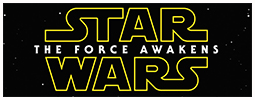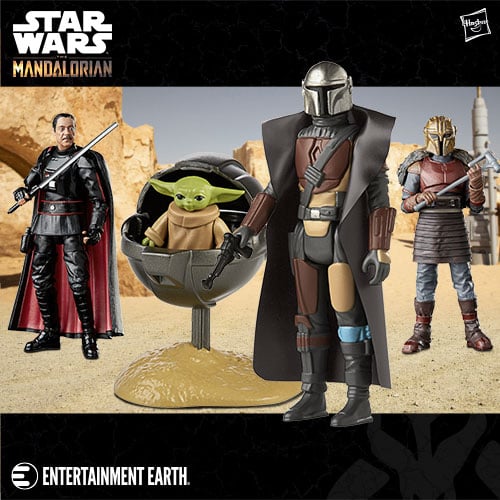Letting Go Of The Past, But Not Forgetting It - Review And Analysis Of Star Wars: The Force Awakens
Posted by Dustin on January 12, 2016 at 06:12 AM CST
TheForce.Net accepts guest op-eds for staff review and publication. The opinions expressed in this op-ed do not reflect the views of TFN or its staff.
By JabbatheHumanBeing, from the Jedi Council Forums
Like each of its major characters, Star Wars: The Force Awakens (TFA), as a film, deliberately and tenaciously hangs onto the past. It struggles to move forward and to chart new territory – away from the deserts, forests and snowy landscapes of its past, and into a wondrous future. But finally, as it stands on the windswept cliffs of Skellig Michael, it does let go. But not without holding onto the best lessons from its past – the themes, the characters, the spirit and the story that made its predecessors so compelling. It’s this theme of letting go of the past, but not forgetting it, that characterizes this film and its story best. Both the story that takes place in a galaxy far far away, and the story of the film within the context of popular culture here on Earth. And it’s this coherence between its in-universe story, and its out-of-universe story, that makes it a great film – right up there with the best in the saga. It is both internally coherent, and meta. It lets go of the past, but doesn’t forget it. And its characters, for the most part, do the same thing.
More importantly, TFA is both timeless and timely. As with previous Star Wars films, it addresses the age-old “hero’s journey.” But it is also very conscious of the current zeitgeist, and the human condition as it exists today. For example, the film's major theme of letting go of the past, but tapping into its wisdom, is consistent with what the film is as a "thing" in popular culture. In essence, it's not just a Star Wars film. It also says something about our current culture - both the mainstream kind (the remix culture that’s concerned with spinning old ideas into new forms) and the subculture of "fandom" (e.g. the commentary on “fandom” characterized by Kylo Ren’s character).
And so, because TFA speaks to the human condition in both a timeless and timely way (as did ANH in 1977), it could be destined to be a classic.
But I’m getting ahead of myself. Here's my far too long review and analysis of TFA. It's a bit flabby, so bear with me. I would have edited it a bit, but in a lot of ways, the ramblings below reflect my frenetic excitement about being in love with a Star Wars film again.
The Plot: The Jedi of the Past are the Key to the Future
I want to get one thing out of the way, as there seems to be some confusion about it. What’s the Force Awakens about? There are two main answers to this question – one related to plot, and the other to theme.
The film’s plot is about the search for the legendary Luke Skywalker. The revival or destruction of the Jedi are the primary stakes. That’s clear from the opening crawl, and from the main thrust of the objectives of both the good guys and the bad guys. And that’s why the film promptly ends once Luke is found. In essence, the movie is one big race, and the runners are the protagonists and the antagonists. The Starkiller threat, the Resistance counter-attack, and all that other stuff, are merely obstacles in that race. Sideshows in the quest to find Luke, as evidenced by the fact that the final First Order-Resistance confrontation really doesn’t get all that much attention (and isn’t introduced until half way into the film)! If the assault on the Starkiller Base feels perfunctory compared to the Almighty Trench Run in A New Hope, that’s because it is supposed to be. The story here is about Rey, Kylo and Finn’s personal journeys, and about finding Luke, not blowing up superweapons.
This is also a personal story more than it is a galactic one, though that personal story has galactic consequences. As General Hux says to Kylo Ren when disputing his obsession with finding the map to Luke Skywalker: “Careful, Ren. That your personal interests do not interfere with orders from Leader Snoke.” That sums up the film’s main plot. The personal goal of Kylo Ren vs. the personal goal of Rey (though she does not know it at the beginning). To find Luke Skywalker. And Luke, a figure of the past, is the key to the future. Either a future of oppression and order, or a future of freedom and democracy. It is a clean, simple story, like the best of our own myths here on Earth. And it echoes what the film is trying to do in reality: looking to the past for lessons, but blazing into the future. JJ Abrams consciously understands that this film wears these two hats, and brilliantly embraces that to create the best film of his career.
The Theme: Letting Go of the Past, But Not Forgetting It
In terms of what the film is about from a thematic perspective, there are a few key themes. But one of its main threads is about letting go of the past, but not forgetting it. All of our major characters except Poe – Rey, Finn, Han, Leia, Luke and even R2D2 - share this struggle.
First, we have Rey, played with an infectious energy by Daisy Ridley. She’s a scavenger on a backwater planet that’s hanging on desperately to her past – the promise of her alleged family. Visually, the film is right along with her, and that’s no mistake. The familiar desert environment is dominated by the wreckage of the blessed Original Trilogy (OT). A world of OT fossils and OT dinosaurs. The Past with a Capital P. Crashed Star Destroyers litter the sandy landscape, and Rey dives into their hulking carcasses, picking them apart until there’s nothing left to pick. Sounds like the last three and a half decades of Star Wars fandom, to be honest. Rey even literally lives within the belly of an AT-AT walker, a vehicle first featured in one of the most beloved of the Original Trilogy’s films – The Empire Strikes Back. Her personal struggle is consistent with this imagery. She needs to stop clinging to her past, move forward, and fulfill her potential. Her first taste of “moving forward,” beyond her initial "rebirth" in the belly of Han's whale of a freighter, is the green of the planet Takodana, which blows her away for a moment (a great little bit of acting from Daisy). But it’s a small step, and to us in the audience, the planet is new but familiar. Just as Maz’s cantina is probably new yet familiar to Rey. But then Rey has a disturbing image of the past, and she begins to be propelled forward. Perhaps Abrams was also giving the audience a jolt too? A distorted, ugly version of the familiar past, as a way of nudging us into a new world?
But let’s move on. Maz Kanata shows up after Rey’s vision and tells her: “the belonging you seek is not behind you. It is ahead.” At first, she rejects this advice. But later, once it’s clear that she must fulfill her potential in order the save the ones she loves, she finally sets her selfish reluctance aside and takes up her father’s sw…I mean, the sword that called out to her. She then accepts that the belonging she seeks is ahead. She climbs a mountain amid a vast sea, where Luke Skywalker, the last Jedi standing like an ancient Druid on the shores of Ireland, awaits her. Her new family – someone from the past (perhaps her past?) - who will help usher in the future (hers and that of the galaxy). But unlike Kylo, as I mention below, Rey does not reject her past entirely. Her scavenger life is a strong part of who she is – her skills and her empathy come from that hardship. And clearly, at least in my view, there’s a force sensitive past that she is tapping into as well. Rey is reaching back in order to move forward. Just like the film.
Secondly we have Kylo Ren, played with nuance and unsettling emotional power by Adam Driver. Kylo hangs onto two pasts. That of his father, Han Solo, and his grandfather, Anakin Skywalker. He hangs onto the light, and his Master (Supreme Leader Snoke) senses it. He hangs onto the conflicted feelings of his grandfather. His past holds him down. Keeps him from fulfilling his potential. Makes him an “adolescent evil” who throws tantrums, and slashes up inanimate objects with his lightsaber as if he is expressing his teenage rage in a video game. On a meta level, he’s a Star Wars fanboy clinging to the icons of the OT. He wants to be an evil, cool badass, like Vader. He talks to Vader’s burnt helmet. He rests his helmet in the ashes of Vader’s incinerated body. Heck, he doesn’t even need his own helmet. As Han Solo says to him on the bridge: “Take off that mask, you don’t need it.” He wears it simply because he wants to be as intimidating as Darth Vader. He wants to look like him. Rey realizes this, and confronts him about it. Hux mocks him like a bully mocking a Vader cosplayer. Kylo’s playing at being a Sith Lord of the past. And he’s afraid that he’ll never live up to those villains (indeed, many fans criticize his character for this very reason). Only when he murders his father as a star is killed and the room goes dark (an excellent visual touch) - when he passes the “inverted” test that Luke Skywalker passed in Return of the Jedi - can he move forward. But as we are likely to see in future installments, he makes a grave mistake. He severs himself from his past completely by killing his father in cold blood. In other words, he refuses the lessons of the past entirely. Ben Solo is dead. And that is his failure. As the Force Awakens novelization states, rather than making him more powerful, killing Han seemed to weaken him. That’s not a throwaway line. The trick is to use the past as a guide for the future, not to reject it completely. But as a villain, he makes the wrong choice.
Thirdly, we have Finn. He is running from his past, sure. But he retains his confused identity, which is a relic of his past. He doesn’t know what he’s “for,” he just knows what’s he’s “against.” He doesn’t want to be a part of the First Order, but he doesn’t know who he is. And so he still dwells in the moral confusion of his life as a stormtrooper. That is, until the Starkiller destroys the Republic, Maz gives him a sword, and tells him to fight for his friends, at the very least. He then surges forward into the future with zeal. He embraces his new role as a hero of the Resistance – fighting to destroy the Starkiller’s shields, and fighting to kill Kylo Ren. But like Rey, he doesn’t ignore his past, and the lessons it offers. He uses his knowledge of the First Order, and its facilities, to assist his new friends, and to chart a purpose for his present and future self. He uses the tools of his past to build the future. Again, exactly what J.J. Abrams is doing within the franchise.
Fourth, we have Han and Leia. In many ways, they are a lot like the old Star Destroyers, X-Wings and AT-AT walkers rotting in the Jakku sun. Both of them are hanging onto their OT pasts. Doing what they were good at: smuggling and generalling. They are also both hanging onto their lost son. This keeps both of them from growing (and even causes them to regress). This also leads them to make what is a selfless, but perhaps foolish decision. To try to reach their son, Ben Solo, and bring him home. But as Kylo Ren tells Han, Ben Solo is dead. Han won’t accept that reality. He clings to the past. Who his son once was. And as a result, he dies a tragic, yet heroic death. Han tries to tap into past feelings – past love – to reach his child. But ultimately, it wasn’t enough. Han is still a hero, and his death is a noble one. But he came into conflict with a major theme of this film: at a certain point, you need to move on. And incidentally, so does Harrison Ford…
Fifth, we have Luke Skywalker himself. He is paralyzed by a past full of failure, guilt and heartbreak. He is rendered impotent, like the mythical Fisher King. Only when the young and hopeful Rey – his Percival – arrives, can he awaken from his slumber, and look forward again. This blend of old and new is brilliantly displayed by the final sequence on Skellig Michael. It is bracing imagery, like a cold sea breeze. And unlike some of the planets we have seen until this point, it is a fresh landscape – like none that we have seen in the Star Wars saga before. This suggests that the past is being left behind. The familiar desert planet, the familiar forest planet, and the familiar snowy planet, all reminiscent of the OT, are now in the rearview mirror of the Falcon.
But not entirely. The island is old, and ancient Jedi huts cling to it like barnacles. An old man in old robes sits atop it. The old hero from the OT, Luke Skywalker. A dinosaur revived. The old will help the new become who they need to be. Luke will help Rey chart her own course. In other words, the OT will impart its wisdom, and help the Sequel Trilogy stand on its own two feet.
Last but certainly not least, we have R2D2! This one’s obvious, but nobody’s talking about it. R2 is in “depressed emo” mode for the whole film. Why? Because he’s sad that Luke Skywalker left. Fifteen years ago! He’s clinging to a rosier past, and refusing to participate in the world of the present. Then Rey arrives, BB-8 does some beeping, and R2 decides it’s time to move forward. He wakes up, delivers the information that’s needed (information he acquired in the past), and in so doing, makes his contribution to the future of the galaxy. As with Luke, he’s a figure from the past that helps set up the future. The old helping the new. R2-D2 and BB-8 come together and chart a new course.
Conclusion: The New Laced With the Wisdom of the Old
J.J. Abrams delivered a perfect baton handoff to Rian Johnson. He took it from Lucas, and ran with it onto a new track. But that baton still had Lucas’ fingerprints on it. The lessons from the OT. Those fingerprints will never fully fade, as many of those story elements are timeless. But over time, as the ST learns to stand on its own two feet, the OT fingerprints will likely become less obvious.
The Force Awakens is a film with a few flaws in execution – a pacing that is a little to frenetic for my tastes, and a few plot points that could have been clearer or more compelling (relationship between the Resistance and the Republic, I’m looking at you). But these are hairline criticisms. Its flaws are absolutely overwhelmed by a masterful coherence across plot, theme, visual language and the film’s place in the Star Wars saga, and in popular culture writ large.
It’s a film about letting go of the past, but not forgetting it. And it’s a film that actually lets go of the past, but doesn’t forget it. It embodies this duality so well across its various elements, that it’s a little hard to believe. Meta, but not overwhelmingly so.
And ultimately, that says a lot about the current zeitgeist. We’re a “remix” culture. We take elements from the past that we like, and spin them into something new. If we’re too lazy about it, we end up simply repeating the past. But if we’re wise about it, we take the best of the past, leave the rest, and create something new, exciting and charged with meaning.
That’s what JJ did with TFA. He took old concepts, and spun them into something new. And in some ways, that’s a more challenging thing to do than creating something out of whole cloth. Frankly, I didn’t think he could pull it off. But he did. And in my view, it may be the best film in the saga.
But don't worry, Empire Strikes Back and A New Hope. I still love hanging out with you guys. But I have a new girlfriend, and need to spend some time with her.
Related Stories:
* Master and Apprentice, a Qui-Gon and Obi-Wan novel by Claudia Gray
* Free Association Thread.
* Gif Response Theory Thread
* Did the prequels ruin the Jedis ?
* Free Association Thread.
* Gif Response Theory Thread
* Did the prequels ruin the Jedis ?








